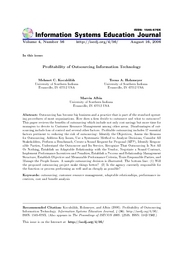Volume 4
Volume 4, Number 56 |
August 16, 2006 |
Abstract: Outsourcing has become big business and a practice that is part of the standard operating procedures of most organizations. How does a firm decide to outsource and what to outsource? This paper reviews the benefits of outsourcing which include not only cost savings but more time for managers to devote to Customer Resource Management among other areas. Disadvantages of outsourcing include loss of control and several other factors. Profitable outsourcing includes 17 essential factors pertinent to reducing the risk of outsourcing: Identify the Objectives, Assess the Reasons for Outsourcing, Address Key Issues, Use a Systematic Method to Analyze Decisions, Consider All Stakeholders, Perform a Benchmark, Create a Sound Request for Proposal (RFP), Identify Responsible Parties, Understand the Outsourcer and Its Service, Recognize That Outsourcing Is Not All Or Nothing, Establish an Adaptable Relationship with the Vendor, Negotiate a Sound Contract, Implement Performance Incentives and Penalties, Establish a Process and Relationship Management Structure, Establish Objective and Measurable Performance Criteria, Train Responsible Parties, and Manage the People Issues. A sample outsourcing decision is illustrated. The bottom line: (1) Will the proposed outsourcing project make things better? (2) Is the agency currently responsible for the function or process performing as well and as cheaply as possible?
Keywords: outsourcing, customer resource management, adaptable relationships, performance incentives, cost and benefit analysis
Download this issue: ISEDJ.4(56).Kocakulah.pdf (Adobe PDF, 17 pages, 781 K bytes)
Preview the contents: Kocakulah.j.txt (ASCII txt, 48 K bytes)
Recommended Citation: Kocakülâh, Holzmeyer, and Albin (2006). Profitability of Outsourcing Information Technology. Information Systems Education Journal, 4 (56). http://isedj.org/4/56/. ISSN: 1545-679X. (A preliminary version appears in The Proceedings of ISECON 2005: §2535. ISSN: 1542-7382.)
x